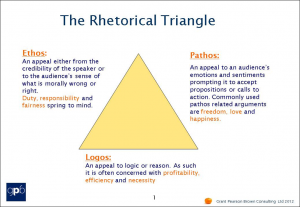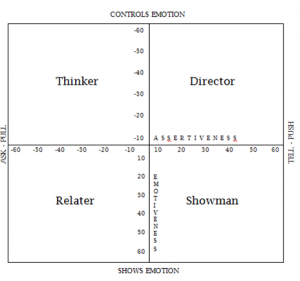By Alastair Grant
At various stages of our progression as presentation advisers, we latch onto ideas that make sense and can be applied to client presentations. After two decades of this two things are apparent: First, is there is lots more to learn; and second, there are recurring themes.
I have a theory that there is a distinct connection between four of those recurring separate themes. Are they all saying the same thing, are they variations on a theme, or are they independent?
These themes are:
- Message and Personality – Key Goals
- The Central and Peripheral paths to persuasion – by Petty & Cacioppo
- The Rhetorical Triangle – Logos, Ethos and Pathos – by Aristotle
- Behaviour Styles – Measuring assertion and responsiveness.
The first theme is the simple idea that just two outcomes should be achieved
in any presentation. First that your message is understood, is persuasive and can be remembered afterwards –
at least the key points; and second that your personality has also to make an impact in terms of credibility, competence and inspiration. They are not always equal partners as situations vary. Listening to the weather forecast is surely much more about message than personality.
A second idea is the concept of Central and Peripheral paths to the brain. Developed by Petty & Cacioppo. They believe that there are ‘Two Routes’ to persuasion: The Central route is about the logic of the message, and the Peripheral route relies on less objective measures such as the attractiveness of the speaker, their voice and other cues.
My theory becomes more complex at this stage, but I can see a connection between the ‘Two Routes’ and the mantra of message and personality listed above.
Then we have the influence of Aristotle. Logos Ethos and Pathos march around demanding our attention and understanding. We describe these three in the form of a ‘Rhetorical Triangle’:

For example, Waitrose has the strap-line: ‘Quality Food honestly priced’. This appeals to Logos and Ethos:
Sainsbury’s strap line ‘try something new today’ is using Pathos as a driver. It says: ‘Be daring, eat what you have not eaten before!:
Asda’s ‘Always low prices’ is simply in the Logos category
Analysis of these suggest that Message/Central Route and Logos are related, but do Personality/Peripheral fit alongside Ethos and Pathos? I suspect both Ethos and Pathos affect the quality of the message and the personality of the presenter.
My fourth theme is ‘Behaviour Styles’. We all have different behaviours based on how assertive and responsive we are. There are many versions of this but all are similar to the model below:
The ‘Director’ style is assertive, controlled and results driven: Don’t waste their time.
The ‘Showman’ style is sociable and uninhibited: They get bored easily with detail.
The ‘Relater’ style is warm and friendly: Trust and rapport is important to them.
The ‘Thinker’ style is more precise and pay attention to detail. Message logic is important to them.
Behaviour Styles shows us that we must adapt our presentation to meet the style of the listener. ‘Different strokes for different folks’ neatly sums it up.
So in conclusion: I believe these four themes do not conflict but complement each other. Here’s what I mean:
Of course we should aim to hit the ball out of the stadium with a logical, clear and memorable message. But we, as speakers should also be credible and trusted.
Petty & Cacioppo’s work shows us that if we fail in the Central or logical route, then the decision will be based on Peripheral cues instead.
And Aristotle shows that the message may not rely on Logos alone but that Pathos and Ethos are equally powerful drivers.
Finally we typically take account of our counterparties’ Behaviour Styles and adapt all the above according to how they tick.
Now for a bit of shopping, but who should I choose to shop with???




